The 1968 Daily Express
London to Sydney Marathon
|
|
The great adventure of the
decade
|

|
In
1967, over a luncheon date, Sir Max Aitken proprietor
of England's
Daily Express newspaper, Jocelyn Stevens and Tommy
Sopwith dreamed up
the idea of a great adventure to try and counter the
despondency felt
in Britain by devaluation of the pound and
anti-establishment feelings
which were to manifest themselves in unrest in cities
all over the
world the following year.
It
was felt that such an event would act as a showpiece
for British
automotive engineering and would result in export
sales in the
countries through which it would pass.
A
committee was set up to organise the event - a 10.000
mile/16.500 km
rally from London to Sydney with a £10.000 first prize
and a £500
trophy to be won. The Daily Express newspaper was to
sponsor the event.
In
order to cover the greatest distance overland with the
most varied
terrain, it was decided to route the rally from London
to Dover, then
by ferry to Calais and then on to Paris, Turin,
Beograd, through
Bulgaria to Istanbul and then to Sivas and Erzincan
and then to Teheran
in Iran, Kabul in Afghanistan, Sarobi in West Pakistan
and on to Bombay
via Delhi.
The
first 72 cars to arrive were to be taken by sea to
Fremantle in Western
Australia where they would be disembarked and then
drive across the
continent to Sydney.
A pair of experienced rally drivers, Jack
Sears and Tony Ambrose were given the task of
reconnoitring the route
to Bombay, making contact with and winning support
from governments,
motoring organisations, police forces and highway
authorities. They
then travelled to Australia where they mapped out the
last 2.800
mile/4.500 km leg.
The P & O
Line agreed to ferry the cars in the S.S. Chusan from
India to Australia.
Over 800
applications were received and 100 were accepted.
Most
of the world's major motor manufacturers entered
teams: BLMC, Ford of
Britain, Ford of Germany, Ford of Australia, General
Motors of
Australia, Rootes, Daf, Volvo, Simca, even Moskvich. A
number of
private entries were also admitted.
|
|
|
|
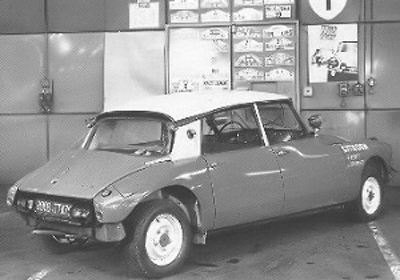 |
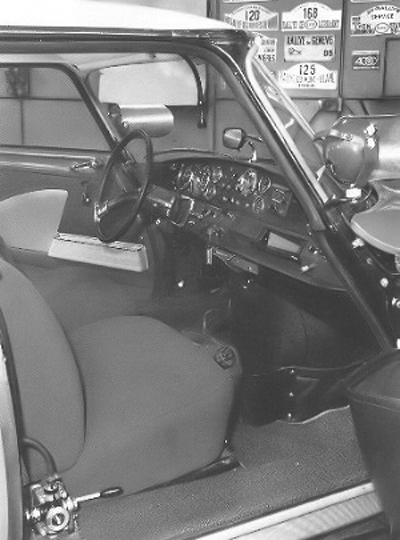 |
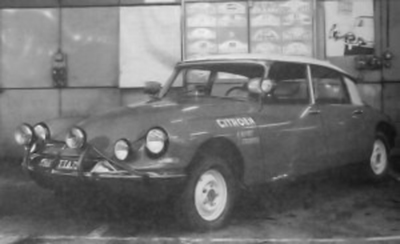 |
|
Three Citroën DS 21s
were entered; two by the factory crewed by Bianchi/Ogier
and Neyret/Terramorsi and the third, crewed by Vanson,Turcat/Lemerle
was sponsored by the Automobile Club de France.
The three cars were lightly modified compared to the
production
vehicles - the engines were detuned to enable them to cope
with low
ocatane fuels, rear wings featured cutaway wheelarches to
enable rear
wheels to be changed without removing the wings, hydraulic
pipes were
mounted inside the cabin, modified dashboards were fitted with
additional instrumentation and the obligatory `roo bars'.
|
|
On 24th November
1968, at Crystal Palace in London, Miss Australia
flagged away the first car, a Ford driven by Bill
Bengry.
|
 |
|
|

|
|
The Marathon had
started! A total of 92 cars were entered.
|
|
|
The first leg of the great
adventure was the run from Crystal Palace in South London to
the Channel port of Dover.
Cheering
crowds lined the London streets to catch the unforgettable
sight of the
most international rallying event yet to be staged.
The
cars were loaded onto the Maid Of Kent ferry and 75 minutes
later,
disembarked at Calais where the reception hall was jammed with
photographers, journalists and well wishers - a phenomenon
that was to
be repeated across the world.
Leaving
at 1 minute intervals, the 98 contestants sped off into the
night
towards Paris. An unexpected hazard on the road to Paris was
thick fog
which at times reduced the cars to a walking pace.
Ice
and freezing fog continued to be a hazard on the early morning
run to
Turin. French customs men decided to enforce currency export
rules and
checked all the crews' money at the Mont Blanc tunnel.
A
number of cars suffered mechanical problems on the Italian leg
but the
three Citroëns stormed on although one of the teams had their
passports
given to another team in an hotel in Turin which caused some
anguish.
Yet
another hazard awaited the contestants - in Turkey, children
threw
rocks at the cars, denting the bodywork and smashing
windscreens.
By
the time the leading cars had reached Sivas, several
competitors had
dropped out. The first `big killer' stage, the route from
Sivas to
Erzincan lay ahead. 170 miles/272 km of twisting mountain
trail, at
night in driving sleet.
Roger Clark broke
away from the rest of the field, covering the stage at an
average speed of very close to 60 mph/100 kph.
The
competitors had a break at Teheran while the cars were handed
over to
the mechanics prior to the longest single stage of the
Marathon, the
1500 miles/2400 km stretch to Kabul through the Elburz
mountains.
First
into Kabul was Harry Firth in a Holden entered by the Sydney
Telegraph.
Only 33 cars managed to arrive within the allotted time.
The
next stage, Kabul - Sairobi - Delhi, added a new hazard -
dust. Paddy
Hopkirk in his works BMC 1800 lost five minutes on this stage
as did
Roger Clark who still remained in the lead. The well tarmaced
road
through the Khyber Pass and into Pakistan presented few
problems and
surprisingly, both Pakistan and India chose to forget their
political
differences and co-operate in allowing the competitors to
cross the
border that had been closed for the previous three years.
The
last Asian stage - Delhi to Bombay, brought more crashes and
breakdowns
but at last, 72 cars were loaded onto the P & O Lines ss
Chusan for
the nine day voyage to Fremantle. Still leading the field was
Roger
Clark in his Ford Lotus Cortina, second was Staepalaere in a
Ford
Taunus 20 MRS and third was Bianchi in the DS
21.
|
 |
 |
 |
|
The nine day voyage
to Australia gave the competitors the chance to relax
and unwind after the hardships of the previous week.
Many
of the drivers went down with stomach upsets and the
Australian crews
decided it was time to put the frighteners on their
rivals, describing
the perils of dust covered potholes and suicidal
kangaroos.
At dawn on
Friday, December 13, the Chusan docked at Fremantle
and the cars were unloaded.
Local police
booked 26 of the competitors for mechanical defects
and illegal equipment such as sirens and flashing
headlamps.
The hostility
of the Australian police was to continue throughout
the rest of the rally.
|
 |
|
The following day,
the cars were lined up for a Le Mans style start at
Perth's Gloucester Park.
Western
Australia's Premier, Mr David Brand and other
celebrities flagged the cars off at three minute
intervals.
Somewhat
ironically, it was the Australians who first had
kangaroo problems although other nationalities had
their share too.
The Marathon was turning into a three-cornered race
between Roger
Clark, Simo Lampinen (The `Flying Finn') in the Ford
Taunus and Lucien Bianchi
in the DS 21. Unfortunately for Clark, his Lotus
Cortina suffered a
piston failure and despite cannibalising Eric
Jackson's car, he dropped
to third place. He made a fantastic recovery however
and managed to
pass Lampinen and push at Bianchi's lead.
Peter
Vanson's DS 21 limped into the Mingary check
point with a suspension failure.
Bianchi however
was still going strong and at Omeo, he had incurred
but seven penalty points against Clark's 12 and
Lampinen's 40.
Bianchi appeared
unstoppable. By now he was five points clear of Clark
who was lying
third. The Taunus then broke a tie rod leaving Andrew
Cowan in the
Hillman Hunter to assume second place.
|
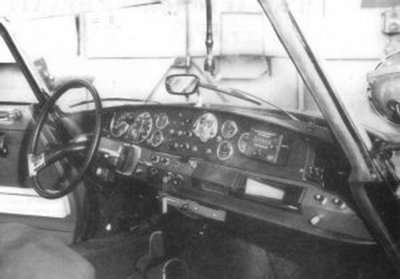 |
 |
 |
 |
 |
And then,
disaster...
The race was all
but won by Bianchi and Ogier. Not far
from the Nowra control point, 156 km (98 miles) from
Sydney, with Ogier at the wheel and Bianchi
dozing in the front seat, the DS 21 hit a Mini
head on in a section of road that was supposed to be
closed to the public.
The DS 21 was wrecked and Bianchi was badly
injured.
Paddy Hopkirk
arrived on the scene and promptly threw up any chance
of winning the rally by turning round and going for
help.
It was
rumoured that the occupants of the Mini were a pair of
off-duty policemen who were both `drunk as
skunks'.
Andrew Cowan
went on to win the Marathon in his Hillman Hunter.
Talking with Dutch Citroën magazine CitroExpert
(in the January/February 2019 edition), Claude Ogier
observed it is still his belief that the ‘accident'
was deliberate.
"There was no traffic at all. I was driving in the
middle of the road,
it was a right turn, and then suddenly there was that
Mini. I sent to
the left, there was enough space to pass each other,
but that Mini kept
coming our way. I could not go anywhere, we were just
being rammed.
Those guys in that Mini had four-point harnesses,
which you only had in
airplanes at that time. We did not have them either,
and we took part
in the race! I am convinced that it was intentional,
probably because
of bets that had been placed, which meant that a
British car had to
win. We did not make any more of it, because that
would not have been
useful, but the disappointment was obviously great.”
|
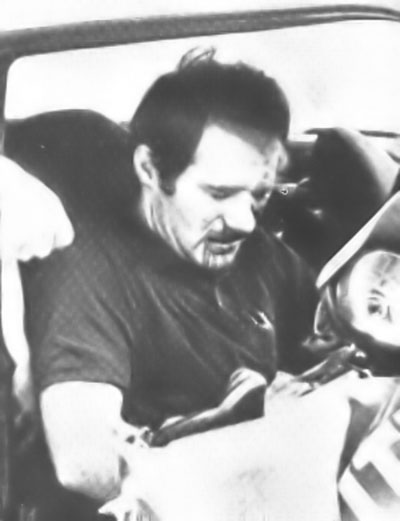 |
 |
|
The Final
Reckoning
Okay,
so Bianchi's DS didn't win and Neyret was placed ninth
but this
fourteen year old design showed it was a match for
anything else on the
road.
The high
pressure hydraulic system which had been so
troublesome when the DS was
first launched had finally come of age and
demonstrated that it was
utterly reliable, even under the most extreme
conditions imaginable.
Since
we Brits manage to turn defeat into victory (Charge of
the Light
Brigade - Dunkirk, etc.) I feel perfectly justified in
saying that
Lucien Bianchi was the moral winner of this incredibly
gruelling rally.
It
was primarily the size of Bianchi's lead - he had an
eleven minute lead
over Cowan and only 39 penalty points as opposed to
Cowan's 50 - that
tells the true story.
The three Citroëns were essentially
unmodified - such modifications that were performed
were designed to
increase the range and provide more information to the
occupants and to
detune the engine to enable it to cope with the low
grade petrol
encountered throughout Asia.
The hydraulic system was unmodified apart from
re-routing the pipework
inside the car to protect it and to enable roadside
repairs to be made
more readily.
Many of the
competitors' cars were extensively modified with tuned
engines, raised and reinforced suspension, etc.
There are some
pictures of a replica of the Neyret Terramorsi vehicle
in the Bruno
Jammes Photothèque.
|

|
|
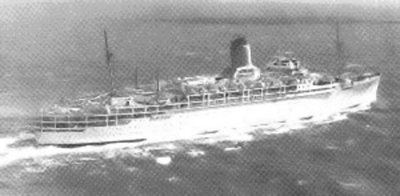 |
|
Above the P & O Line S.S. Chusan
Lampinen
and Staepalarae were booked by the police in Victoria
for speeding
after a 75 mph/120 kph chase. The police threatened to
impound the car
at one stage.
Soon
after leaving the Omeo check point, Clark suffered a
broken
differential but, encountering a Cortina by the
roadside, tried to buy
the rear axle. The owner initially refused but then
said `You're Roger
Clark, the English driver, aren't you?' and parted
with his rear axle.
After an 80 minute delay at
the local garage while the axle was fitted, Clark was
once again back in contention.
|
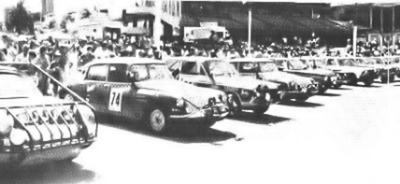 |
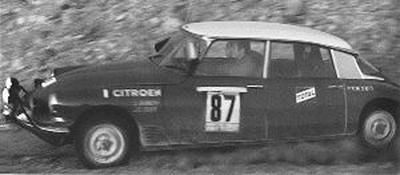 |
 |
|
So confident where
Citroën Cars Ltd that Bianchi had won the
rally that they put a full page
advertisement in most of the British newspapers
of the day.
|
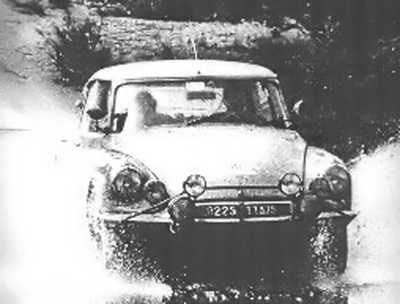 |
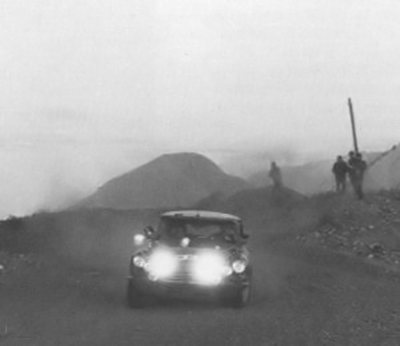 |
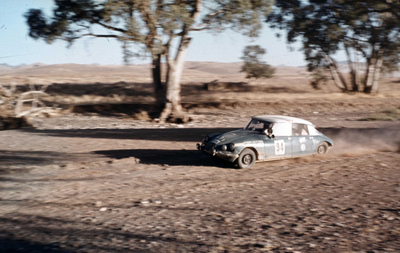 |
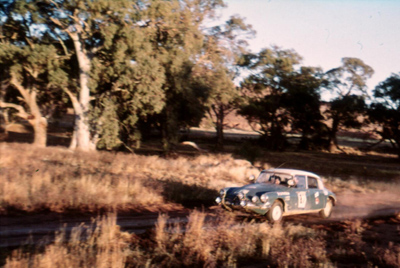 |
 |
 |
 |
 |
 |
|
Acknowledgments:A
number of people assisted me in this project,
including, in Europe,
Wouter Jansen, John Reynolds and Andrew Minney, and in
Australia, John
Stafford who was absolutely invaluable in providing
the antipodean
perspective and John Waterhouse who provided the two
colour pictures of
Bianchi's car in the Outback and Craig Keller.
The Daily Express was singularly unhelpful, declining
to respond to either e-mails or letters.
© 1996 and 2019
Julian Marsh and 2019 CitroExpert
|
|





































